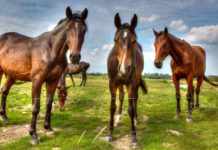Frankfurt am Main, Germany (Weltexpress). Bernd Paschel interviewed exclusively for Weltexpress the US horses researcher and founder of the Veterinary School at Tufts University Massachusetts, Professor Dr. Robert Cook. Cook, a 1952 graduate of the Royal Veterinary College, London, has been a surgeon/teacher most of his career with a research focus on the equine ear, nose and throat. Moving to the USA, he helped to establish the veterinary school at Tufts University, Massachusetts in 1979. He has published two books, one with Dr. Hiltrud Strasser from Germany, and over a hundred scientific articles. In 1997, he was the first to research the effect of the bit on the horse and develop what is now known as a crossunder bitless bridle.
Paschel: Dr. Cook, some people call you “the father of bitless riding” but would it be more accurate to call you a researcher on the bit and bitless riding?
Cook: Yes. Bitless riding was first discovered by pioneers about six thousand years ago. They probably first used a noose around the neck (today’s neck strap) and then a simple halter. In time, the bitless approach led to the bosal, hackamore and sidepull; all of which are less painful methods of communication than the Bronze Age bit. The word ‘bit’ comes from the Anglo-Saxon ’bite’ but horses don’t need to be bitten to respond to a rein-aid. They can feel a fly landing on their face – touch is enough. Pain is overkill and a barrier to partnership.
My contribution to equine welfare and rider safety has been to ask the question, ‘What does a bit do to a horse?” Realizing, late in my career, that a bitted bridle was the cause of avoidable pain and accidents, I developed a more humane and safer alternative.
Paschel: As bits are depicted on old Greek vases, has man gone astray for centuries?
Cook: Yes. Early domesticators of the horse assumed that a horse could be tamed by pain. Accordingly, man applied this at one of the horse’s most sensitive parts – its mouth. Over thousands of years, succeeding generations have repeated the same mistake, with a tendency to increase the severity of the bits used and the number employed at any one time. Similarly, each generation has failed to recognize the size and significance of the bit’s health-and-safety side-effects. The reality is that the bit violates a body cavity and is, inescapably, a painful and counter-productive method of communication. A bit does not control a horse. Quite the reverse; the bit is the most common cause of complete loss of control. Blissful ignorance of the havoc a bit precipitates, coupled with the ‘status quo’ habit of traditional thinking, accounts for how it is that such a primitive instrument survives as ‘standard practice’ right up to the present day.
Paschel: Before we come to the alternative of riding without a bit, please describe some of the bit’s disadvantages. Is it possible for you to substantiate, in a few words, your reasons for condemning the bit?
Cook: Short questions can sometimes require long answers. I will try to summarize but for the details go to ‘Further Reading’ and, in particular, to items 9 and 20. I recognize over two hundred behavioural disadvantages in using a bit and no advantages. In addition, I find the bit responsible for over forty diseases. The disadvantages and diseases can be summarised anatomically in three ways; the bit’s negative effect on the horse’s brain, lungs and legs.
BRAIN: Bit pain frightens a horse. In the short term, this makes a horse nervous, highly-strung and inclined to spook (shy). They can become as nervous as a long-tailed cat in a room full of rocking chairs. In the long term, bit pain can lead to depression, unresponsiveness and resignation (learned helplessness). Horses are prey animals, evolved to be acutely alert to anything that threatens their safety. Pain and fear account for a legion of survival-based responses, all of which from the rider’s point of view are ‘unwanted behaviours.’ Many of these are the cause of accidents and injury to horse and rider, some of them fatal. For example, a bit is the most common cause of bolting, bucking, rearing, and balking. Pain and fear are also character-altering. Many a bitted horse is unfairly blamed for having a ‘bad attitude’ or being aggressive, when in reality the horse is entirely innocent and the fault entirely ours. Unwanted behaviour ‘under saddle’ is most commonly caused by the person in the saddle.
LUNGS: The horse is a nose breather. In the wild, a horse runs with lips sealed, teeth opposed, tongue immobile, mouth dry, and poll extended. A bit interferes with all of these. Lips tend to be parted; the mouth often gapes; the tongue is on the move, salivation stimulated (hence the high-risk need to swallow when breathing rapidly at exercise) and poll flexed.
Because the root of the tongue is hung from the base of the skull by the same bony scaffolding that supports the voice box at the entrance to the windpipe (Fig.1), the torrent of air being sucked and blown – to and fro – through an agitated and obstructed throat is often turbulent. The horse has to work harder to breathe, yet gets less oxygen. A bit triggers the ‘eating’ responses of chewing, salivating and swallowing, all of which are in conflict with the ‘exercising’ responses needed for performance, i.e., rapid breathing, increased heart rate and improved oxygenation of limb muscles. Exercise requires movement of the limbs, not mouth.
My research tells me that, when running at liberty, a horse’s oral cavity is a potential cavity only and under negative pressure, i.e., air is absent and a partial vacuum exists. Like the collapsed cavity of an unopened trash bag, this serves to keep the soft palate firmly in contact with the root of the tongue. Palate and tongue stick together like two wet blankets. This permits the airway in the throat to remain fully open at exercise, resisting what would otherwise be a partial or complete collapse of the airway at each breath. Readers can simulate this collapsing effect and observe it, standing in front of a mirror, by consciously relaxing their nostrils and, with a closed mouth, taking one sudden and forceful ‘sniff.’ Both nostrils collapse under the suction forces, the airway is choked, and the effect can be felt right down to the diaphragm. It is this same effect that occurs in a horse’s throat when the soft palate is not stuck to the root of the tongue by an oral vacuum.
A bit breaks the lip seal, destroys the vacuum and, together with bit-induced poll flexion, obstructs breathing. Because of suffocation (choking), a bitted horse can become exhausted, stumble, fall, sprain tendons, breakdown, dislocate joints, break bones, develop waterlogging of the lungs, ‘bleed’ and die. Oedematous, bruised and bleeding lungs become less efficient gas exchangers and, in turn, impede the circulation of blood through the rest of the body. The heart is put under strain, blood pressure rises and, in a vicious circle, leg muscles are further deprived of oxygen.
This catastrophic cascade is triggered, I maintain, by what is referred to in the literature as ‘dorsal displacement of the soft palate’ (DDSP) or ‘palatal instability’ (PI). In spite of DDSP being such a common problem (hence the regrettable acronyms), the currently accepted wisdom is that this is a disease of unknown cause, explaining why its name describes a symptom rather than a cause. Swimming metaphorically upstream against the current of opinion, I beg to differ. In my experience, DDSP is caused by the bit. The name I propose is ‘bit-induced nasopharyngeal asphyxia’ or, for a name that falls more trippingly off the tongue, ‘choking-on-the-bit.’
LEGS: Running at liberty, a horse takes one stride for every breath. Striding and breathing are hard-wired in synchrony. At the gallop, a horse may be breathing/striding at a ‘strike rate’ of 140 a minute. An oral foreign body interferes with this rhythm. The poetry of motion can be lost and the gait become short, choppy and heavy on the forehand. Of all the unwanted behaviours caused by the bit, gait problems are the most numerous. A bit can leave a horse breathless and ‘legless.’
In short, a bit is incompatible with the physiology of exercise, an impediment to performance, a hazard to the health and safety of horse and rider, and a handicap to rider/horse communication. The bit is a device diametrically opposed to the development of that harmony between rider and horse which is the goal of all riders and the very reason for riding in the 21st century.
Paschel: It seems that the key to understanding the conflict caused by the bit is to better understand the workings of one particular section of the horse’s anatomy, its throat. Could you expand on this?
Cook: Yes, correct functioning of the throat is crucial to life itself. It is a crossroads for two vital pathways; one for food and water going to the stomach when at rest, and one for a gale of wind going to and from the lungs when on the move (Fig. 1). At the muzzle, the nostrils lie above the entrance to the mouth (air-way above food-way) but in the neck the relationship is reversed (food-way above air-way). The throat has to serve two functions, e.g., breathing or drinking. These are either/or functions, one job at a time. The proverbial ‘drinkers of the wind’ should not, when taking two and a half deep breaths a second (try doing this yourself), have to deal with a bit-induced flow of saliva of up to 50 ml. or 3 tablespoons a minute (six swallows a minute for us). They can either swallow or inhale the saliva but both options have serious respiratory consequences. If they swallow, they risk choking. If they inhale, they start to drown.
At liberty, anatomical ‘gates’ in the horse’s throat act like gates at a rail/road crossing. When breathing, the soft palate gate is in the ‘down’ position and the flapper cartilage gates of the voice box are in the ‘up’ position, opening the airway and closing the gullet. Conversely, when drinking, the soft palate is ‘up’ and the flapper cartilages are ‘down’, closing the airway and opening the gullet.
As with rail-road crossing gates, if something interferes with the pas de deux of the throat gates, fatal accidents can occur. Because a bit sends the wrong signal (swallowing instead of breathing) and takes the soft palate gate off its ‘latch’ (by destroying its vacuum packaging) a bit is an ever present source of accidents. The bitted horse’s soft palate is at risk of becoming unstable and a barrier to air ‘traffic.’ As we say, a bit can ‘throw a spanner in the works.’
Metal in the mouth can render a horse distrustful of its rider, distressed, dyspnoeic (short of breath to the point of suffocation), diseased, disabled and even dead. Continuing the ‘D for disaster’ theme, riders can be dissatisfied and disappointed with their riding skills, discouraged, dismounted and, yes, occasionally dead.
Paschel: I don’t need a knowledge of science to imagine how I would feel if I were a racing cyclist trying to compete with a painful rod of metal in my mouth.
Cook: Yes, even as a child you would have instinctively understood that it was not a good idea to run round the garden while eating an apple! Removal of the bit does wonders for the gait of a horse. The stride becomes longer and the forehand lighter. Of keen interest to owners, racehorse owners in particular, longer stride means faster speed. Some of the natural grace of a horse at liberty returns. Just as, in man, the most critical part of swimming is breathing so, in the horse, the most critical part of running is breathing.
The point of balance of a stationary and riderless horse lies on a vertical line just behind its 13th thoracic vertebra. When mounted and in motion the point of balance shifts forward and the horse becomes heavier on the forehand. One or more bits in the mouth also shift the point of balance even further forward. First, it does this because of the dead weight of the bits at the end of the head/neck ‘pendulum.’ Secondly, because the rider is maintaining a pressure on the bit (the FEI advocated ‘contact’), this too adds ‘weight’ to the horse’s forehand. Thirdly, a horse instinctively arches its back slightly and lowers its head (‘leans on the bit’) in order to carry a rider’s weight. Pretend to be a horse and give your grandchild a ride to understand this need.
In order to defend itself from the pain of the bit and the bit’s unbalancing effect, a horse either clamps the bit between its teeth and bears down in response to rein pressure, or traps the bit under its tongue and does the same. As soon as a bit is removed, a horse’s footfall lightens, as can be demonstrated by listening to the soundtrack of a video film. A horse that is heavy on the forehand is unbalanced. It has a shorter stride, a ‘choppy’ action and no ‘self-carriage.’ A heavier forehand puts greater stress on the bones, joints and tendons of the forelegs. Racehorses are more likely to breakdown.
Paschel: You can simulate this situation by means of a simple test. If you get down on all fours and an assistant places increasing pressure on your chin with a belt, you will perceive how, as the pressure increases, your hands exert greater pressure on the ground.
Cook: Thank you! That is an interesting idea and I have now tried it.
On ‘all fours,’ with a straight bar snaffle in my mouth and the reins held by an assistant in such a way that the bit made contact with the corners of my mouth on the weight of the reins alone, I moved slowly forward on hands and knees as rein pressure was steadily increased in six stages. In this way I sensed, as you say, that palm pressure increased as rein pressure increased. In order that I could retain my balance and resist the bit’s elevation of my head, I found that I was ‘bearing down’ (leaning) on the bit.
However, I had no means of measuring palm pressure. So I then carried out a stationary test using my bathroom scales as a simple ‘force plate.’ I weigh 142 lbs (64 kg) and, at rest, with the palms of my hands on the scale platform (3 inches [7.5 cm] above ground level), the scales registered 50 lbs (23 kg.). Repeating the rein pressure test several times, to the point at which I was unwilling to experience any greater pain in my mouth, palm pressure registered a maximum of 60 lbs (27 kg) on each occasion.
When stationary, the threshold rein pressure I tolerated resulted in a 10 lb (4.5 kg) increase in pressure on my ‘forehand’ – a 20% increase over baseline pressure. If it had been possible to carry out the same test at the walk or trot, greater pressures would have developed, as I feel sure they would if I was carrying a grandchild. When stationary, with rein pressure limited to the weight of the rein, moderate ‘hand-bouncing’ produced spikes of 80lbs (36 kg). Again, it is reasonable to assume that a ‘head bob’ in motion would result in greater pressures.
This pilot experiment supports your observations.
Paschel: This presents a wonderful opportunity for researchers to pursue this approach, using the force plate technology now available. People talk about “rein aids” and “fine aids” but, if I understand you correctly, a bitted rein aid is not a help as the word suggests but a hindrance and senseless punishment?
Cook: Yes – even in the hands of a master, a bit is a handicap for both horse and rider. The term ‘bit aid’ is a contradiction in terms – an oxymoron, like ‘bit control.’ No horse willingly ‘accepts’ the bit. If it was not strapped in, it would be spit out. Understandably, horses resist the obligatory bit by ‘fighting back’ against its painful and unbalancing effect. FEI Article 101, which requires that “no resistance should be offered to the Athlete,” is unattainable because of the very equipment and its ‘contact’ that the FEI mandate. Current competition rules contain many such internal contradictions because of rules and standards that are not compliant with the physiology of exercise. Paradoxically, judges penalize riders when their horses do things they would never have done if they had not been bitted.
A further problem is that most of us do not have independent seats. As a result, we use the reins to balance ourselves in the saddle; unbalancing and hurting the horse. Inadvertently, the rider with a metal-tipped rein starts the fight; the horse fights back; and the tug-of-war escalates. The horse is blamed for being a puller, hard-mouthed or a bolter. Yet the horse is merely responding to simple genetic rules such as, “when out of balance – rebalance” and “when frightened – run.” Jockeys and harness horse drivers (armed with 3 meter reins), use their body weight and more to apply horrendous force on the bars of a horse’s mouth. The wonder is that catastrophic accidents do not occur more often.
When a horse is ‘on the bit,’ the bit is on the bone. Even light but constant ‘contact’ must lead to bone ache in the jaw and a waste of energy in locking-up the neck muscles. This neck-brace effect does not happen in the horse at liberty, nor when ridden without a bit. Strap on skin trumps steel on bone. Rigidity of the neck is incompatible with optimum athletic performance. Years ago, Dr. James Rooney referred to rigidity of the head/neck pendulum in Standardbreds, caused by overchecks and head poles. “Try running a few hundred meters” he said “with your neck in a cast.” No human athlete could perform well without freedom of the neck. A horse cannot balance (be in ‘self-carriage’) if its head and neck are restrained; for example, as in hyperflexion of the poll (Rollkur).
An ‘acceptable’ rein-aid (acceptable, that is, to the horse) should be painless. Aids of any kind should be polite requests, not orders backed by force. They are signals for communication not coercion. Rein-aids seek a horse’s willing cooperation and should not be mechanical or ‘power-assisted.’ They are not akin to the brakes and steering wheel of a car.
For the majority of riders, the rein of a crossunder bitless bridle meets the need for a painless signal. For the minority (i.e., those with an independent seat) two other painless rein-aids are available. The first is the neck strap (cordeo). The second is less familiar and has apparently been overlooked even in that part of the world where it was first developed. I refer to the Bedouin bridle, a bridle that I have only come to know myself in the last six months. Since January 2013, I have been working with Dr. Fridtjof Hanson, a retired cardiovascular surgeon and lifelong horseman in New Zealand. Thanks to pure serendipity on my part and extraordinary perception and skill on Hanson’s part, in December 2014 he rediscovered and has shown me the value of the Bedouin bridle.
Both the cordeo and the Bedouin bridle invoke the horse’s sense of touch. Both also invoke its sense of proprioception, a sense that offers an even more accurate way of signalling than touch. Proprioception is the sense of awareness of body position and movement in space and is a vital component of the sense of balance. Both make use of the rider’s and horse’s sense of balance. The Bedouin rein has the advantage of linking the rider with the horse’s proprioceptive ‘headquarters’ – its head. However, with both aids the horse senses the rider’s balance and vice-versa. In this way, horse and rider are ‘united,’ the horse is unimpeded and the ultimate ‘centaur’ of two athletes is possible.
Paschel: Now, I think, we must refer again to your 1999 article “PATHOPHYSIOLOGY OF BIT CONTROL IN THE HORSE”. Riders encounter many behavioural problems. To what extent are these caused by the bit?
Cook: The great majority! Non-acceptance of the bit is so common that its many forms have ‘stable’ names. Horses are described as ‘spitting the bit’, getting their tongue over or behind the bit, lolling the tongue, ‘mouthing’ (moving the tongue, lips and jaw), chewing or champing on the bit, sucking the bit, ‘getting the bit between their teeth’, pulling, boring (leaning on the bit), crossing the jaws, opening the mouth, slobbering, foaming at the mouth, head tossing and head shaking. Other unwanted behaviours relate to many a bitted horse’s total aversion to ridden exercise and to a legion of unwanted interferences with stride.
Evasion of the bit can be the sole cause of inspiratory stridor (the noise of partial suffocation) at exercise, with air turbulence and vibration (‘fremitus’) in the voice box, detectable by palpation immediately after exercise. Such episodes of ‘roaring’ can be differentiated from less common causes of suffocation (e.g. paralysis of the voice box) by simply riding the horse again without a bit in its mouth. If airway obstruction at fast exercise is ever complete, even momentarily (e.g., due to spasm of the voice box or by the soft palate blocking the two orifices that connect the back of the nasal cavity with the throat, see Fig.1), no respiratory noise will be heard and the horse will die quickly and silently. The sudden death of a racehorse is an all too familiar occurrence.
Unlike most animals, horses will tolerate a foreign body in their mouth without going berserk (try this on a dog) but this is not because they like it. No horse really ‘accepts’ the bit. Its presence interferes with a rider’s attempt to communicate and a horse’s ability to understand. Acute or chronic pain inflicted by the bit, impels a horse to immobilize it by grasping it between his premolars. Once this happens, rider-to-horse signalling is impossible and the horse is ‘in charge.’ Shakespeare describes it succinctly
“The iron bit he crushes ‘tween his teeth,
Controlling what he was controlled with.”
In recent years, the problem of dorsal displacement of the soft palate has led, in Thoroughbred and Standardbred racing in the USA, to the adoption of what has become an item of harness. Grotesquely, in the hope of preventing a horse choking-on-the-bit, its tongue is strapped to its lower jaw.
The mechanism whereby a bit can choke a racehorse is the same as that which serves to throttle or threaten to throttle a victim of waterboarding. The tortured victim’s throat is flooded with water, instilling in him the fear of sudden death by drowning or suffocation (from spasm of the voice box). Similarly, many a galloping horse has to breathe rapidly and deeply with its throat flooded with saliva and its airway collapsing. If its airway is only partially obstructed its lungs get bruised at every breath from the damaging suction pressure to which they are exposed. In a few cases, the tell-tale sign of this may be ‘bleeding’ at the nostrils but undisclosed damage to the lungs is that described in the medical literature as negative pressure pulmonary oedema (NPPO – find more information on the internet) and in the veterinary literature as exercise-induced pulmonary haemorrhage (EIPH). The horse may or may not make a gurgling noise like a death rattle but its performance will quickly be diminished. Some horses suffer a spasm of the voice box and die silently. The jockey would not report hearing any sign of respiratory distress. These incidents may be explained away by racetrack press releases as ‘sudden death from probable heart failure.’ Unaware that heart failure can be a sequel to suffocation, the general public are willing to accept this explanation as ‘just one of those things.’ In this way, adverse publicity is avoided, calls for change ignored and ‘business as usual’ continues.
Paschel: Is the head shaking habit yet another problem caused by the bit?
Cook: Yes. As the result of evidence gathered since 1997, I now recognize that the bit is the most common cause of head shaking. To rule-out this cause, I recommend test removal of the bit (for at least one month) as the first step in investigating such cases. Many horses show signs of improvement in the first week but some take weeks to recover fully. Head shaking is, in my experience, one of the many signs of trigeminal neuralgia brought on by persistent pressure of the bit. In man, the pain of neuralgia (tic doloreux) in this same trigeminal nerve is notoriously severe.
Paschel: Few riders are able to examine their horse’s mouths. If they could, what would they be able to see or feel?
Cook: Bit pressure causes bruising of the gums, laceration of the tongue and lips, bone spurs on the bars of the mouth (Fig.2), star fractures of the interdental space, erosion of the cheek teeth in the lower jaw (Fig.3) and even shedding of teeth.
A bit lies close to any wolf teeth under the gum in the lower jaw, or just erupting through the gum in front of the first cheek teeth. Pain is caused if the bit beats up against or rolls over these vestigial teeth. The cheek pieces of a snaffle and curb bridle press the horse’s cheek against sharp enamel edges on the upper cheek teeth and commonly cause ulcers.
Racehorses are at the height of their careers between the ages of two and five, when their permanent dentition is erupting and their mouths hypersensitive. If one asks a Thoroughbred or Standardbred trainer what percentage of horses in their barn they expect at any one time to have sore mouths, the answer ranges from 20 to 60%.
Paschel: Is there one good reason for using a bit?
Cook: No. There is only one reason but it is not a good one. In many disciplines, bits are mandated for competition. This false “necessity” occurs at the horse’s expense and makes nonsense of the horse sport objective “the welfare of the horse is paramount”. Administrations that mandate bit usage in the 21st century can no longer claim to be safeguarding the welfare of the horse.
Paschel: That is a rational but disturbing conclusion. Thank you for your analysis.
* * *
Further reading: www.bitlessbridle.com/15FURTHERREADING.pdf
Photo Gallery: www.bitlessbridle.com/horsemanship.pdf



















